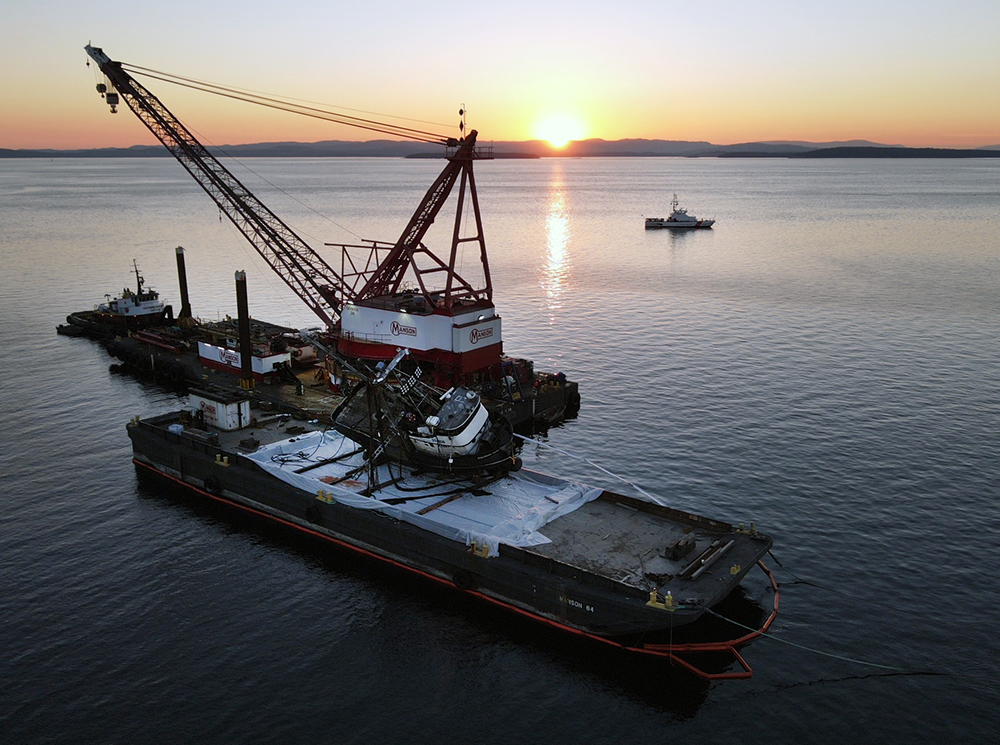
A commercial fishing vessel that sank near Washington’s San Juan Island on Aug. 13, with estimated 2,600 gallons of diesel and oil on board, was successfully lifted to the surface as part of a lengthy process that ended the evening of Saturday, Sept. 17.
The lifting of the Aleutian Isle began during that weekend afternoon and continued late into the night. The Coast Guard said after the vessel was brought to the surface that the crew began the complicated task of dewatering and removing fuel. The vessel was partially dewatered and approximately 775 gallons of oily-water liquids were removed, but crews were unable to safely access all spaces and completely dewater the vessel.
The Aleutian Isle is now floating with assistance from the barge DB-24.
The incident commander, Coast Guard Cmdr. Kira Moody, said that the complexity of the operation continues to challenge its team. Lifting the boat was a critical first step to minimize the ongoing pollution risk. Moody said the next step would likely involve relocating the crane barge to a more sheltered location, so that the boat could be secured with much less risk to divers and crew and protect the environment from lingering pollution risk.
The Coast Guard explained that continuing to lift the vessel in its current position would jeopardize the safety of crews needing access to the starboard fuel tanks and internal spaces to continue with dewatering and remove fuel to lighten the vessel.
While the crane could lift the vessel at its current weight, the Coast Guard said the existing configuration of the rigging put too much stress on the vessel’s structure and could cause the vessel to break and release any remaining fuel.
Meanwhile, the Coast Guard said pollution mitigation measures had been effective. Responders were able to boom sheening. Estimates to identify how much fuel is being released were still in progress. Wildlife and pollution mitigation tams were successful in deterring birds from sheening areas during lift operations.
The Coast Guard said its teams were continuing to monitor sheening, while locating marine mammals and birds and impacts to the shoreline.
As of Sept. 21, the vessel had been recovered, defueled, on a salvage barge and no longer posed a significant threat to the environment, according to the U.S. Coast Guard.

Plans were to transit the Aleutian Isle to a mainland facility for further investigation into the cause of the sinking.
U.S. Coast Guard Cmdr. Kira Moody, the federal on-scene coordinator representative, said that the unique environment of the San Juan Islands and location of the vessel made for a complicated and technical response.
The 58-foot fishing vessel was recovered from over 250 feet of water in Haro Strait after weeks of complex dive operations. It was later towed to Mitchell Bay to provide divers and response crews a safer, shallower environment to prepare it for the final lift out of the water.
San Juan Office of Emergency Management Director Brendan Cowan was the local on-scene coordinator.
“This area is special and unique. It has an incredible diversity of marine life,” Cowan said. “The whale deterrence team has spent countless hours monitoring and protecting the Southern Residents and other species from any sheening.”
Throughout the response, killer whale experts were on standby to deter killer whales from areas of active sheening, with extra attention on the endangered Southern Resident killer whales. Deterrents were successful during two separate events with a pair of transient killer whales.
Birds landing in surface sheening was also a concern, especially the endangered marbled murrelet, Coast Guard officials said. Deterrence teams used proactive deterrence with air cannons and vessels to prevent birds from moving through areas of sheen.
Dave Byers, the state’s on-scene coordinator from the Washington Department of Ecology, said monitoring for any residual fuel that could impact the shoreline or wildlife was continuing.
